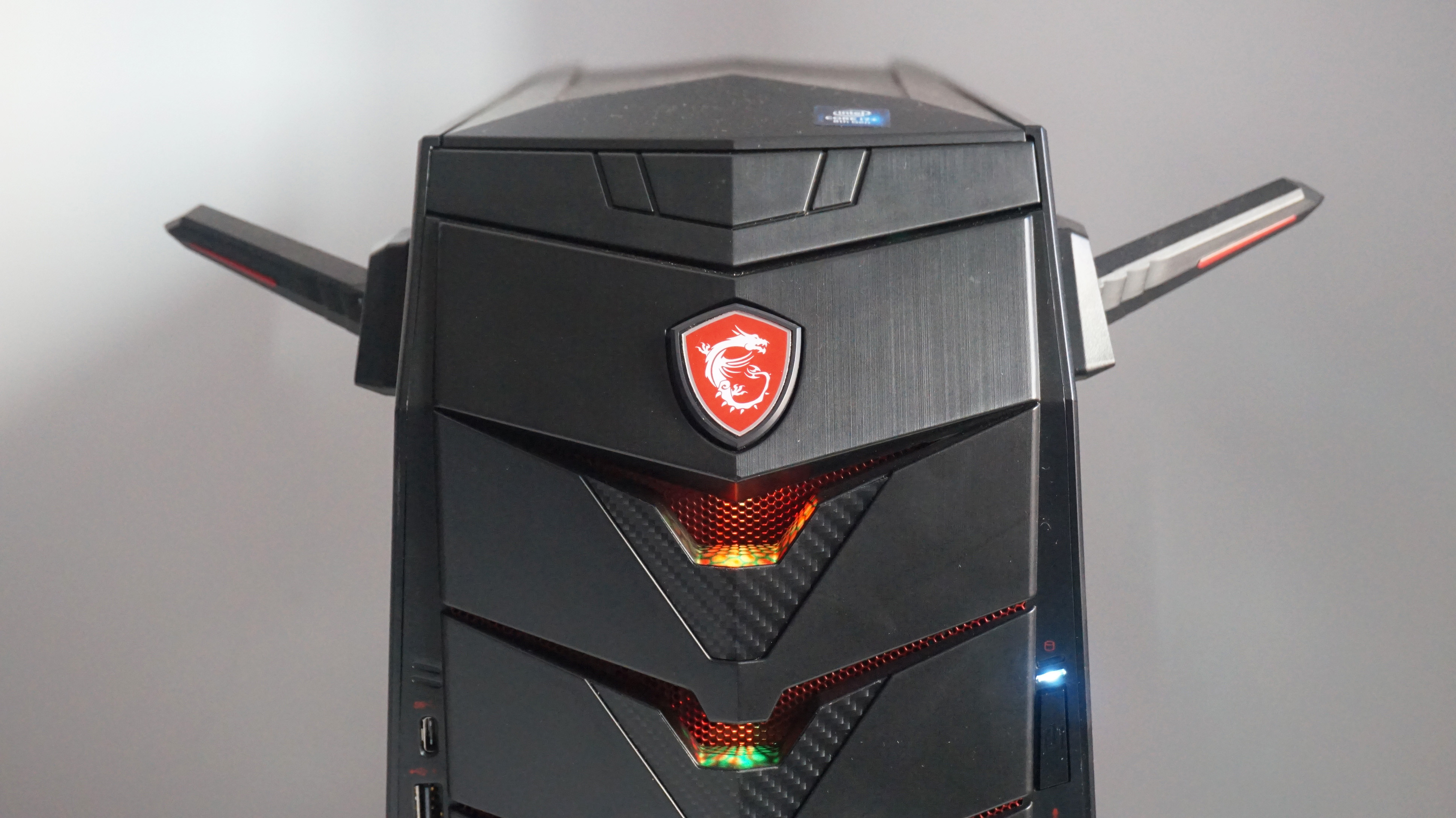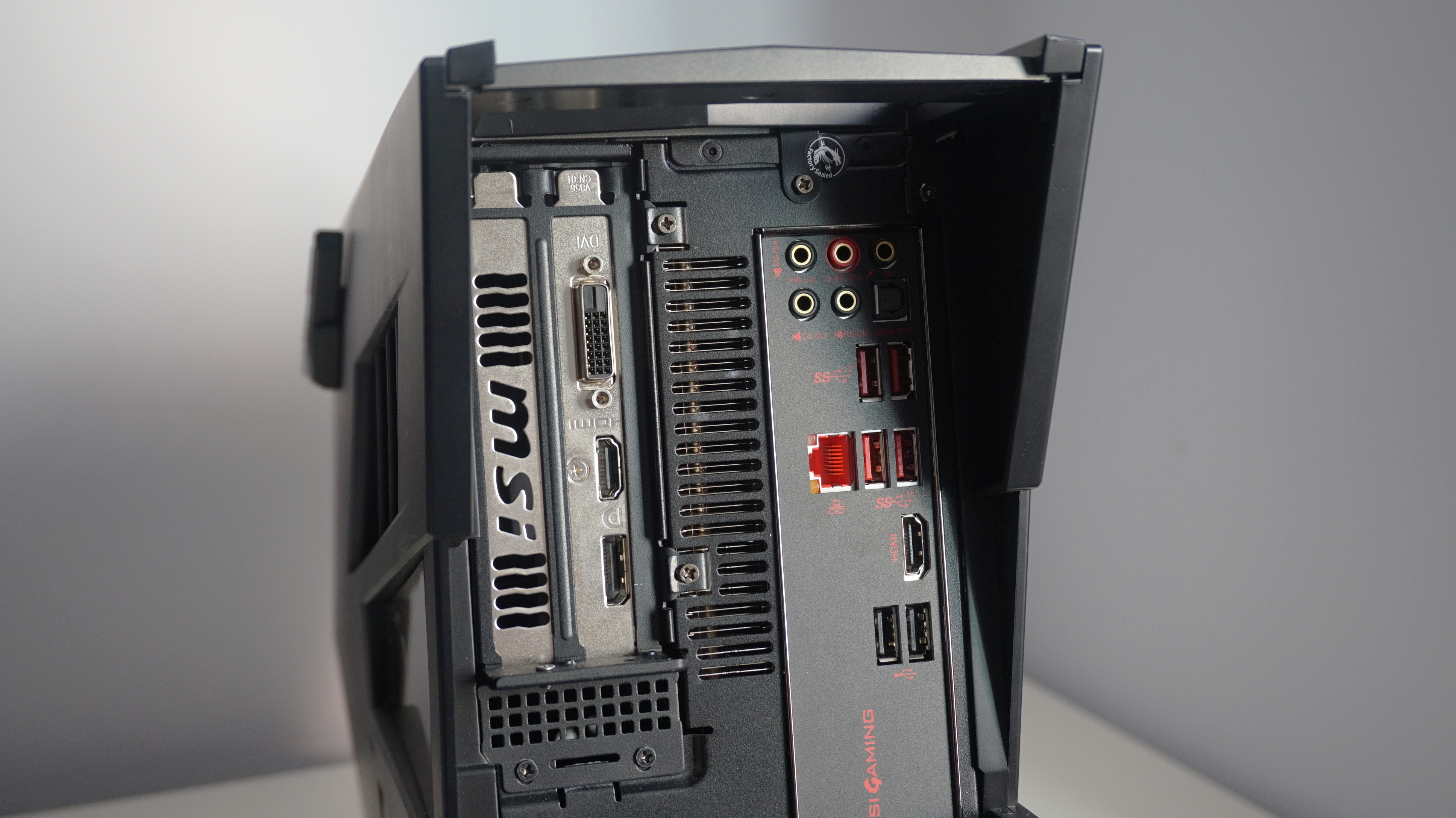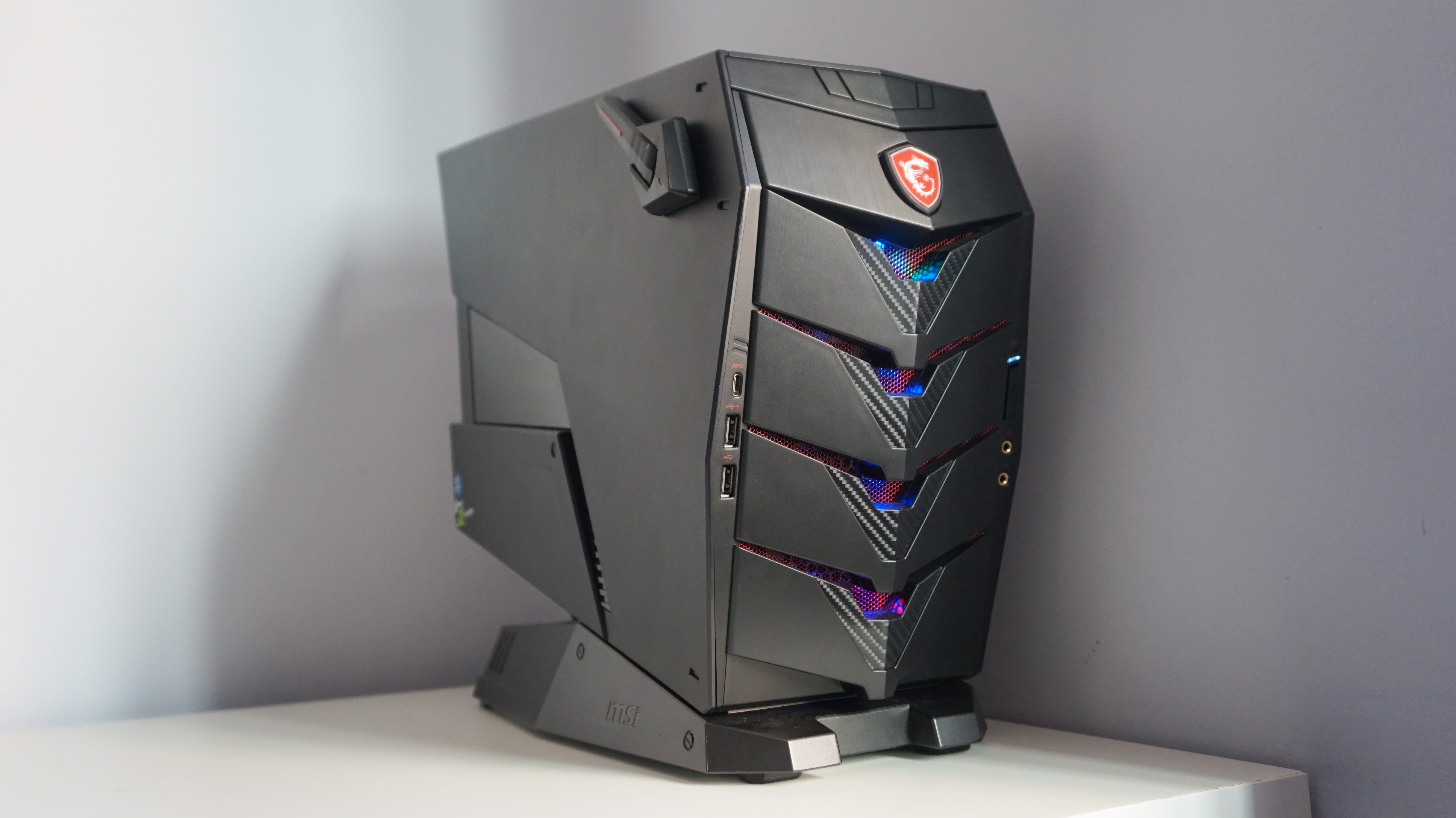MSI Aegis 3 8th review: The PC that thinks it's from Dead Space
One for the ages?
When I opened up the box containing MSI's Aegis 3 8th PC, I wasn't entirely sure whether I was looking at a miniature desktop or the disembodied head of Dead Space protagonist Issac Clarke. With its pointed stack of glowing RGB strips and dark, angular chassis, the Aegis 3 is a dead ringer for Clarke's ominous helmet, albeit without the added decoration of spattered Necromorph blood round the outside. If you've ever wanted a PC that looks like a piece of video game box art, the Aegis 3 definitely fills that tiny niche.
This alone should give you a pretty good idea of MSI's small form factor PC is the kind of thing you'd want looming over in the corner of your desk, but there's also its surprisingly beefy innards to consider as well. For inside this titchy case, you'll find an Intel Core i7-8700 CPU, Nvidia GeForce GTX 1060 graphics card, oodles of storage and Intel Optane Memory support. Let's take a look.
Before we begin, however, let's have a small word about the Aegis 3's various specs. As with a lot of pre-built PCs, the Aegis 3 comes in a number of different configurations. The model I've been sent for review came with the aforementioned Core i7-8700, GTX 1060 and 16GB of Intel Optane Memory built into its 1TB hard drive, which was also accompanied by a 128GB SSD, but a lot of the Core i7-8700 models I've seen available in the UK aren't quite the same. They either seem to come with a 2TB / 256GB storage combo without any clear indication of whether they've also got any Optane Memory, or they do come with Optane Memory but pack a Nvidia GeForce GTX 1070 card instead a GTX 1060.
As for Aegis 3 models in the US, the GTX 1070 seems to be the only graphics card available with the Core i7-8700 version, and once again appears to come with the same 2TB / 256GB storage pairing and hazy clarification on whether it has any Optane Memory support.

As such, prices are a little bit all over the shop, with the Aegis 3 ranging from £1400 to £1800 in the UK depending on which spec you get, while in the US you're looking at around $1525 for a more powerful model than what I'm reviewing here. I'll do my best to cover as many bases as possible, but performance-wise this will be very much looking at what's possible with a GTX 1060 rather than the more powerful GTX 1070.
With that out of the way, let's get down to business. As miniature desktop PCs go, the Aegis 3 is pretty dinky. Measuring just 433x376x170mm, it's noticeably smaller than Zotac's MEK1, and probably makes less of a hum when sitting idle as well. It's by no means the quietest PC I've ever used - I reckon something akin to the noise an air conditioning unit makes is roughly what to expect while sitting idle, and something close to a hair dryer being used in the next room when it's under load - but it's certainly not the loudest either.
Despite its small dimensions, MSI have designed the Aegis 3 to be easily upgradeable, too, as both the sides and top of the PC can be unscrewed to add in new components at a later date. When it comes to upgrading your graphics card, you'll obviously have to make sure you get one that actually fits inside the chassis, but at least the option's there if you have your eye on one of Nvidia's fancy new Turing RTX 2080 cards.
So how about those games, eh? Well, overall, the Aegis 3 performed roughly in line with other GTX 1060 systems I've tested, such as the Zotac MEK1 and MSI's own console-shaped Trident 3 8th - that is to say, a highly competent 1080p machine that managed to run almost all of my test games at the highest possible settings and still get a silky smooth 60fps, and a very decent 1440p machine where 60fps often wavered somewhere between Medium and High settings.

There are a few exceptions to that rule, of course, as both Doom and Wolfenstein II: The New Colossus were up in the 70-90fps region on their respective Ultra and Mein Leben settings at 2560x1440. Similarly, both broke the 120fps mark when using the same settings at 1920x1080, with Doom even pushing into the realms of 140fps.
Hitman was another example that bucked the trend of only being able to use Medium settings at 1440p, as its built-in benchmark returned a very competent 54fps average with everything set to Ultra. Lowering the resolution to 1080p sadly didn't see much of an improvement here - an average of just 56fps - but that's pretty much in line with what I've seen on other PCs I've tested in the past.
I also didn't have to deviate too much from Rise of the Tomb Raider's top Very High setting at 1440p as long as I kept the anti-aliasing options in check. With the lowest FX anti-aliasing enabled, for instance, the game's trio of internal benchmark scenes saw an average of 48fps on its top setting, with highs reaching all the way up to 67fps in the taxing Geothermal Valley test. FXAA on High is probably the surest way to maintain a constant near-60fps at 1440p, all told (my results came out with an average of 57fps), but you'll only loose around five frames across the board by opting for the next AA option up (SMAA) if edges become a bit too rough for you. At 1080p, however, you can be confident of getting around 65fps on Very High as long as you stick to SMAA.

Elsewhere, however, max settings often returned results somewhere in the 40-50fps region at 2560x1440, which is still perfectly playable if detail is more important to you than overall speed, but those chasing a perfect 60fps at 2560x1440 will likely have to temper their expectations somewhat when it comes to graphical fidelity.
Total War: Warhammer II, for example, is always a tough customer regardless of what graphics card you've got, and here battles averaged out to around 41fps on High at 1440p, and a much more pleasing 52fps on Medium. Frame rates were smoother out on the campaign map, hitting an average of around 51fps and 60fps respectively, but if you're the type of person who likes to watch your battles play out right at the tip of your Lizardmen's spears without even the slightest judder in speed, you're probably better off sticking with Low. 1080p saw a more promising picture, as you're probably looking around 46fps battles on Ultra at this resolution, or a perfect 60fps (technically an average of 64fps) on High, with campaign map speeds pushing well into 70fps region on both settings.
Middle-earth: Shadow of War fared a little better at 1080p, with its internal benchmarking tool returning an average of 57fps on Ultra at 1080p, but at 1440p it was definitely most comfortable on Medium again. Here, the Aegis 3 came in with an average of 39fps on Ultra at 1440p, 49fps on High, and a lovely 65fps on Medium.
The same roughly goes for The Witcher III as well, as jogging through the forests of White Orchard saw the frame rate settle somewhere in the 40-50fps region on High at 1440p depending on whether I was being assaulted by drowners or not, whereas Medium saw a much more stable average around the 55-60fps mark. That said, the Aegis 3 struggled to run everything on max when I dropped the resolution down to 1920x1080, as here the frame rate tended to max out at around 50fps on Ultra, with the occasional dip to 45fps. Instead, it was High that saw the frame rate shoot back up to that lovely smooth 60fps - which, again, is fairly standard compared to other GTX 1060 PCs I've tested.

Some games, however, struggled to maintain even 50fps on Medium at 1440p, so you may have to opt for Low in a couple of cases if they're particularly demanding, or simply bite the bullet and settle for playing at 1920x1080. Assassin's Creed Origins' internal benchmark only managed an average of 53fps on Medium at 1440p, for example, while Final Fantasy XV's 1440p Average settings hopped between 45-50fps with all of Nvidia's fancy tech bits turned off and dipped closer to 40fps when I switched on TurfEffects and HairWorks.
At 1080p, however, both games performed much better, with Assassin's Creed hovering around the 58fps on Very High and Final Fantasy XV ranging between 58-68fps on Highest sans Nvidia effects, and settling somewhere around 50-58fps with TurfEffects and HairWorks enabled.
Overall, though, these results are pretty much what I'd expect from a GTX 1060-powered machine, which at this point in time is both good and a little worrying. It's good in the sense that the Aegis 3's small chassis clearly isn't crippling its performance compared to other small form factor desktops I've seen, but worrying in the sense that the GTX 1060 is becoming increasingly unable to run newer and shinier games well at 1440p.
This is fine if all you're after is something to play games at max settings at 1920x1080 - with that I have no issue. But if you're looking for a pre-built 1440p-capable gaming PC, the GTX 1060 is likely to become an increasingly compromised option going forward. In this sense, I'd probably recommend 1440p hunters try and find one with a GTX 1070 inside it, as that will likely give you better future-proofing for at least another year or so.
One thing you don't have to worry about, however, is the Aegis 3's CPU. With a six-core 3.2GHz Intel Core i7-8700 on board, this is more than capable of tackling anything you throw at it. It wasn't quite as nippy as the same model inside MSI's Trident 3 when I put it through Geekbench 4, all told (probably because it only comes with 8GB of RAM rather than the Trident's 16GB), but with a single core score of 5012 and a multicore score of 19205, it's still one of the quickest CPUs you can buy today.
I'm less convinced you need to shell out the extra cash for an Intel Optane Memory model, though, as my AS SSD speed tests on the 16GB Optane Memory-infused 1TB hard drive in my review unit left something to be desired. When Optane Memory is paired with a hard drive, it's meant to give it almost SSD-like performance, helping to cut down on loading times and get you playing games faster.
The drive's write speed was undoubtedly impressive, coming in at 52MB/s in the 1GB random 4K test. That's just under what I recorded for WD's Blue 3D NAND SSD, which managed 56MB/s. Its 3MB/s read speed, however, was diabolical in comparison - around what I'd expect from a regular HDD - and a long way off the WD's 29MB/s.
I also wasn't hugely impressed by its 128GB Intel-branded NVMe SSD, either. It's still a better bet for storing your games on if you're really that worried about loading times - especially when most retail models seem to be offering 256GB's worth of space - but it's still only about as fast as your typical SATA SSD, offering random 4K read speeds of 28MB/s and write speeds of 91MB/s. Still, I'm not that fussed about having the latest, greatest storage on a PC like this, especially when it can all be upgraded at a later date if need be.
Ultimately, though, I think those in the US probably have the better deal when it comes to deciding whether the Aegis 3 is good value for money or not, as here you can get a GTX 1070 Optane Memory-less configuration for $1525. UK buyers, on the other hand, either have to make do with a GTX 1060 one (also sans Optane) for not that much less at £1400, or fork out another £400 for that GTX 1070 future-proofing. You needn't spend that much extra if your target resolution is only 1920x1080, of course, but it's nonetheless disappointing that it's so much more expensive compared to what's on offer across the pond.
Personally, I'd probably prefer to skimp on the processor and save myself a couple of hundred quid and get the £1180 Zotac MEK1 instead. However, if having a Coffee Lake Core i7 CPU is important to you and you don't mind the Dead Space helmet aesthetic MSI's got going on here, the Aegis 3 certainly has a lot to recommend it, either as a GTX 1060 1920x1080 PC, or a GTX 1070 2560x1440 machine.


